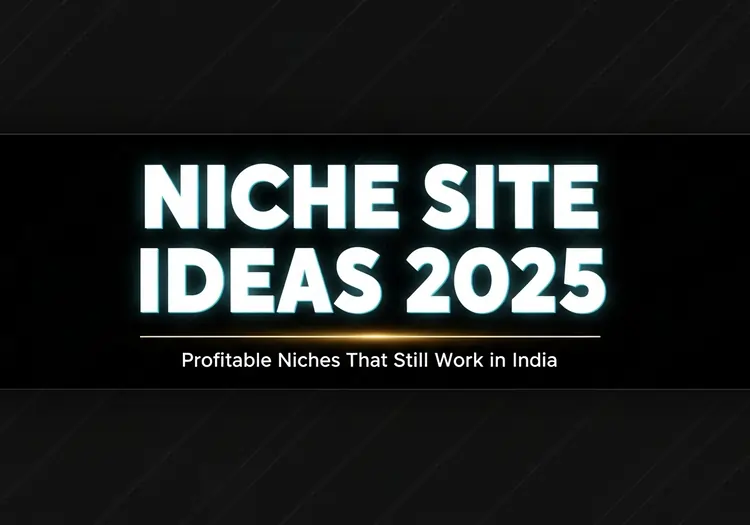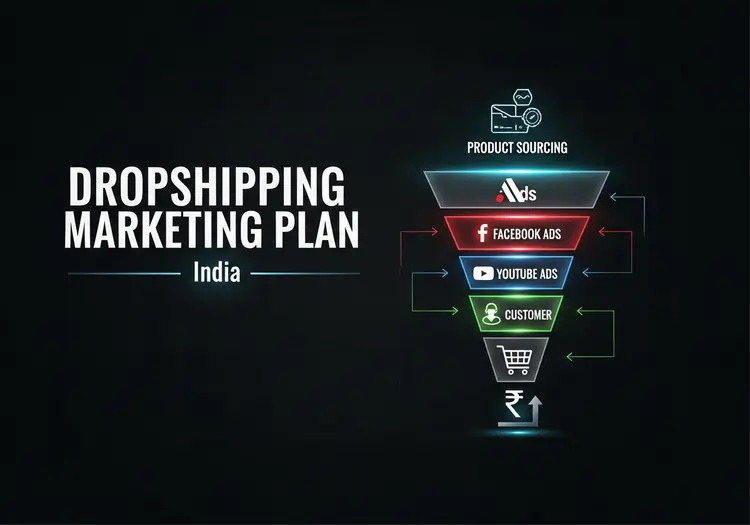Niche site ideas 2025 are no longer about chasing random keywords. In India’s fast-changing digital market, the right niche can decide whether your blog earns ₹5,000 a month or scales into a full-time business.
Think of it this way: ad costs are rising, competition is tougher, and Google’s AI Overviews are rewriting how people discover content. Yet, niche sites still work—if you pick the right idea and execute with clarity. As Deepak Singh, Founder of The DM School (Google Partner; 1 Lakh+ students), I’ve seen this first-hand: our campaigns have generated over ₹100+ crore in revenue for businesses across India.
Table of Contents
What Are Niche Site Ideas in 2025?
Niche site ideas 2025 are focused website topics built for a narrow audience, validated by demand, monetization, and low competition.
A niche site targets a tightly defined topic or audience. It wins by depth, not breadth, and converts better because content matches specific intent. Definitions vary across leading guides like Shopify and Ahrefs, but the core idea is the same: go narrow, serve deeply.
Why care now? Content marketing is big business. The global content marketing industry was valued at $413.2B in 2022 and is projected to reach $2T by 2032 (Statista, 2024). Niche sites ride this wave by creating targeted, useful content that searchers and buyers want.
Unlike others that list random topics, this guide is India-first and execution-driven. If you understand what a niche site is, you’ll shortlist smarter ideas and avoid broad, unfocused blogs that rarely rank. For fundamentals on discoverability, see our primer on What is SEO.
Summary: You now have a crisp definition. Now you can spot real niche opportunities.

Why Niche Sites Matter for Indian Entrepreneurs in 2025
India’s digital landscape is exploding. With over 900 million internet users in 2024, expected to cross 1 billion by 2025 (IAMAI), the opportunity to serve micro-audiences in regional languages has never been bigger. For creators who go deep on a single topic, the audience pool is massive and still underserved.
Snapshot: India’s affiliate marketing industry is projected to cross ₹6,600 crore by 2025 (KPMG India). This means niches tied to finance, e-commerce, and career development carry real monetization potential for site owners.
Unlike generic blogs that fight for scraps, niche sites can build topical authority and win both SEO rankings and user trust faster. Rising ad costs make this model even more attractive: focusing on one profitable niche improves ROI on every click. That’s why agencies like ours invest heavily in narrow but scalable niches for clients. Learn more in our Digital Marketing Services in Delhi guide.
Summary: India’s digital boom makes niche sites a smarter, higher-ROI play for 2025.
Core Components of a Profitable Niche Site
Every profitable niche site in 2025 is built like an engine with multiple gears. Miss one, and the entire machine slows down. These are the five non-negotiable components that separate hobby blogs from serious revenue-generating sites.
1. Traffic Validation (Don’t Start Blind)
Ideas without validation are just guesses. Before investing time, confirm:
- Search demand: Minimum 20–30K monthly searches across your cluster.
- CPC floor: At least ₹30–₹40 for monetizable niches; high-value niches like finance push up to ₹400.
- SERP mix: Look for blogs dominating results. If Quora, Reddit, or forums appear in the top 10, it’s a sign the niche is still open.
Validation isn’t optional—it’s your insurance against wasted months.
2. Topical Authority (Google Rewards Depth)
Google’s algorithms in 2025 reward sites that own a topic. That means building content clusters instead of random posts. For example, if your niche is “credit cards in India,” you’d cover:
- Best credit cards for students, travel, cashback.
- Comparisons: HDFC vs ICICI vs SBI cards.
- Guides: “How to apply for a credit card in India.”
Covering 360° of a topic creates semantic signals that tell Google you’re the authority.
3. Content Volume Benchmark (The 50–70 Rule)
A new site typically needs 50–70 high-quality articles to get traction in competitive spaces (Ahrefs, 2025). In low-competition niches, you might see results earlier, but volume plus consistency is what compounds. Plan to publish 20–30 articles in the first 30 days, then keep a steady cadence.
4. Monetization Pathways (Clarity Before Traffic)
Traffic without monetization is a vanity metric. Decide upfront:
- Ads: Display ads via AdSense or Ezoic work well in high-volume niches (news, entertainment).
- Affiliate: Best for product niches — from smartphones to edtech courses.
- Digital products: Create eBooks, mini-courses, or templates once traffic builds.
- Lead generation: Capture leads for local businesses or services — a big opportunity in India.
Example: Our Ad Process blueprint shows how monetization clarity multiplies ROI.
5. Trust & EEAT Signals (The Invisible Multiplier)
With AI-driven search results, Google looks harder at Expertise, Experience, Authority, and Trust (EEAT). Add:
- Clear author bios with credentials.
- Outbound citations to authoritative Indian sources (IAMAI, RBI, government sites).
- Case studies, testimonials, or results — e.g., “₹100+ crore revenue generated by The DM School.”
These trust signals are no longer “nice to have.” They’re ranking factors in disguise.
Pro Tip: Don’t stop at interlinking articles. Build mini-funnels inside your niche site. Example: Cluster → comparison guide → product review → affiliate CTA. This funnelized structure can double conversions compared to random blog posts.
Summary: Validation, authority, volume, monetization, and trust are the five gears of every profitable niche site in 2025.
Advanced Factors in 2025 (AI, SGE, CPC Niches)
Running a niche site in 2025 is not the same as it was even two years ago. Search engines are evolving, competition is being automated with AI, and monetization economics have shifted. To stay profitable, you must adapt to four advanced realities.
1. Google SGE and AI Overviews (Traffic Shift)
Google’s Search Generative Experience (SGE) now appears on 40–50% of global queries (Search Engine Journal, 2025). In India, this shift is visible in high-volume categories like finance and education. Many site owners fear it will “kill” traffic — but that’s only true if you publish unstructured content.
- Write with FAQ blocks, tables, and schema markup so SGE can cite your site.
- Add India-specific context that AI-generated overviews miss — like RBI regulations or local pricing.
- Design content for extractability. Clear definitions, numbered lists, and concise facts get quoted more often.
Reality: Structured, India-first sites are more likely to get featured, not buried.
2. High CPC Niches (Profit Pockets in India)
Monetization potential is directly tied to CPC. In India, finance and insurance niches reach ₹250–₹400 CPC (SEMRush India, 2025). That’s why blogs on loans, insurance comparisons, and investment guides are consistently profitable.
Other lucrative 2025 niches include:
- EdTech & online courses: India’s edtech market is valued at $10B+, with CPC often above ₹100.
- Health & wellness: Supplements and fitness niches combine mid CPC with strong affiliate demand.
- AI & SaaS tools: Subscription-driven, global audiences, and high-paying affiliate programs.
By contrast, lifestyle or travel niches average CPC under ₹20, requiring huge traffic volumes to break even.
3. AI-Powered Competition (Volume vs Depth)
Competitors are using AI tools like Jasper, SurferSEO, and Copy.ai to pump out hundreds of articles. These sites rank initially but lack depth, local signals, and authority. This creates a hidden opportunity:
- Add real-world case studies — e.g., “How an SBI credit card user saved ₹12,000 annually.”
- Leverage Hinglish keywords (“best loan apps India 2025”) — untouched by global AI blogs.
- Blend multimedia — YouTube Shorts, Instagram Reels, WhatsApp groups — channels AI blogs can’t replicate.
Competitor callout: Unlike generic Elementor or Themeisle lists that recycle Western niches, this guide maps CPC, traffic, and cultural signals specific to India.
4. Future-Proofing with Brand Thinking
The era of faceless blogs is fading. In 2025, niche sites that scale are treated like brands. Here’s how:
- Email list first: Every article should build your owned audience.
- Micro-products: Sell ₹499–₹999 eBooks, mini-courses, or templates alongside affiliate offers.
- Multi-channel presence: Repurpose articles into video, LinkedIn posts, or Quora answers to diversify traffic.
Think beyond traffic and ads. Build assets — mailing lists, products, and communities — that survive algorithm shifts.
Summary: In 2025, survival means adapting to SGE, chasing high CPC niches, outsmarting AI competitors, and building brand assets.
Best Tools & Platforms for Niche Sites
Choosing the right platform is one of the biggest decisions for building a niche site in 2025. The wrong CMS or hosting stack can lock you into high costs or limit your ability to scale. Here’s a breakdown of the best options for Indian creators and entrepreneurs.
1. WordPress (Most Flexible)
WordPress powers over 40% of all websites worldwide. It remains the top choice for niche site builders because of flexibility, plugins, and SEO control. Pair it with a solid host for speed and uptime. For India, Best Hosting in India can guide you on affordable, high-performance options.
2. Shopify (E-Commerce Heavy Niches)
If your niche involves selling products (physical or digital), Shopify simplifies checkout, payments, and shipping. While more expensive than WordPress, its built-in sales tools make it ideal for D2C brands and e-commerce-focused niches. However, SEO customization is more limited compared to WordPress.
3. Substack & Ghost (Newsletter-Centric Niches)
Not every niche needs a traditional blog. If you’re targeting knowledge-sharing niches like investing tips, parenting, or career advice, Substack and Ghost allow you to build direct email audiences. Monetization here is through subscriptions, sponsorships, and digital products.
4. YouTube + Blog Hybrid
For niches like tech reviews, fitness, or education, a hybrid approach works best. Build a YouTube channel for discovery, then drive viewers to your site for in-depth guides and affiliate offers. This dual-channel model multiplies visibility — a common success pattern in India’s edtech and finance niches.
| Platform | Best For | Pros | Cons |
|---|---|---|---|
| WordPress | SEO-driven content sites | Full control, plugins, flexible monetization | Requires technical setup |
| Shopify | Product-heavy niches | E-commerce ready, secure, easy payments | Less SEO customization, higher cost |
| Substack / Ghost | Newsletter-first niches | Direct audience, recurring revenue | Limited design flexibility |
| YouTube + Blog | Video-driven niches | Multi-channel traffic, stronger branding | Higher content production effort |
Pro Tip: Don’t get locked into one platform. Many top Indian creators run WordPress blogs for SEO and Substack newsletters for retention — while testing e-commerce funnels on Shopify. The hybrid model de-risks you from algorithm updates.
Summary: WordPress rules for SEO, but hybrid setups win in 2025. Match your platform to monetization goals.
90-Day Execution Plan for Launching a Niche Site
Most people overthink and delay. The truth is, you can take a niche site from idea to live traffic in 90 days — if you follow a focused system. Here’s the plan we recommend at The DM School, built from launching 100+ projects across India.
1. Week 1–2: Validate Your Niche
Use Ahrefs, SEMrush, or free Ubersuggest to confirm 20–30K monthly searches and a ₹30+ CPC floor. Cross-check with Indian forums (Quora, Reddit) for real audience pain points.
Micro-win: End Week 2 with one validated niche + seed keyword list.
2. Week 3–4: Build the Foundation
Register a domain, set up WordPress with fast hosting (see Best Hosting in India), install a lightweight theme, and configure SEO plugins. Don’t get lost in design — focus on speed and structure.
Micro-win: By Week 4, your site loads under 2.5s with clean navigation.
3. Week 5–6: Publish Your First 20 Articles
Target long-tail Hinglish and regional queries first. Write product reviews, how-tos, and FAQs. Use interlinking to form mini clusters. Even if imperfect, volume builds topical authority fast.
Micro-win: By Week 6, Google Search Console starts indexing pages.
4. Week 7–8: Layer in Monetization
Add affiliate links, simple lead capture forms, or AdSense. Create one digital product idea (eBook or checklist). Even ₹499 offers can validate demand and build early cash flow.
Micro-win: End Week 8 with your first clicks or email sign-ups tracked.
5. Week 9–10: Promote & Distribute
Repurpose blog posts into LinkedIn carousels, Instagram Reels, and Quora answers. Use WhatsApp groups for hyper-local niches. Paid ads are optional — organic hustle matters more at this stage.
Micro-win: By Week 10, you’ve earned at least 100 organic visits/month.
6. Week 11–12: Optimize & Scale
Check Google Analytics and Search Console. Double down on articles gaining impressions. Update headlines, add schema, and improve CTAs. Plan your next 30 articles based on real keyword data.
Micro-win: By Day 90, you have traffic, early monetization, and a roadmap for scaling.
Pro Tip: Don’t chase perfection in the first 90 days. Imperfect execution beats endless planning. The faster you ship, the faster Google starts rewarding you.
Summary: In 90 days, you can validate, launch, publish, monetize, and start ranking your niche site.
Frequently Asked Questions on Niche Site Ideas 2025
What are the most profitable niche site ideas in 2025?
The most profitable niche site ideas 2025 include finance blogs (₹250–₹400 CPC), education/edtech guides, AI tool reviews, SaaS comparisons, and health content. In India, finance and education niches dominate because advertisers spend heavily on these categories, making them ideal for affiliate and ad revenue.
How can I find low-competition niche site ideas in 2025?
To find low-competition niche site ideas 2025, use keyword tools like Ahrefs or SEMrush with KD filters below 20. Check if Quora, Reddit, or forums rank in the top results — that’s a sign of low competition. Adding Hinglish or regional keywords often reveals untapped traffic in India.
Is affiliate marketing still profitable for niche sites in 2025?
Yes. Affiliate marketing is still highly profitable for niche site ideas 2025. India’s affiliate market is expected to cross ₹6,600 crore by 2025 (KPMG). Niches like finance, SaaS, and education pay the best commissions, provided you build trust and show expertise with EEAT signals.
How many articles are needed to rank a niche site in 2025?
Most niche site ideas 2025 need 50–70 quality articles in the first 6–9 months to rank well (Ahrefs, 2025). Publishing topic clusters of 5–7 posts around each subtopic helps Google view your site as an authority, improving indexing speed and search visibility.
Which niche site ideas have the highest CPC in 2025?
The highest CPC niche site ideas 2025 in India are finance (credit cards, loans, insurance) with ₹250–₹400 CPC. Other strong options include SaaS tools, AI products, health supplements, and online courses. Lifestyle or travel niches average below ₹20 CPC, requiring massive traffic to be profitable.
Can I monetize niche site ideas in 2025 without using ads?
Yes. Many niche site ideas 2025 make money without ads through affiliate programs, digital products like ₹499–₹999 eBooks, online courses, or even lead generation for local services. Ads are optional — hybrid models with affiliates and products usually deliver higher ROI than display ads alone.
How does Google SGE affect niche site ideas in 2025?
Google’s AI Overviews (SGE) now show on 40–50% of queries. For niche site ideas 2025, this means sites with FAQs, schema, and India-specific insights are more likely to be cited. Content that combines clear structure with local context has a big advantage over generic lists.
Conclusion: Turning Niche Site Ideas 2025 Into Profits
Niche site ideas 2025 are not about chasing trends blindly. They’re about picking the right topic, validating demand, building topical authority, and choosing monetization models that fit. In India, finance, education, AI, and health niches stand out because of high CPC and growing user demand.
The rules have changed — Google SGE, AI-driven competition, and rising ad costs make execution more important than ever. But the opportunity is bigger too: India will cross 1 billion internet users by 2025, creating endless micro-markets waiting to be served.
Remember, success comes from consistent publishing, smart interlinking, and trust signals. Whether you choose WordPress, Shopify, or a hybrid model, focus on execution speed and clarity of monetization. Six months from now, you could be running a site that earns daily revenue while compounding long-term authority.
Pro Tip: Don’t try to do it all alone. A strategy call with experts can save you months of wasted effort. Start smart, not slow.
Ready to launch your own profitable niche site? Book a Free Strategy Call with The DM School today and turn your niche idea into a revenue-generating business.


